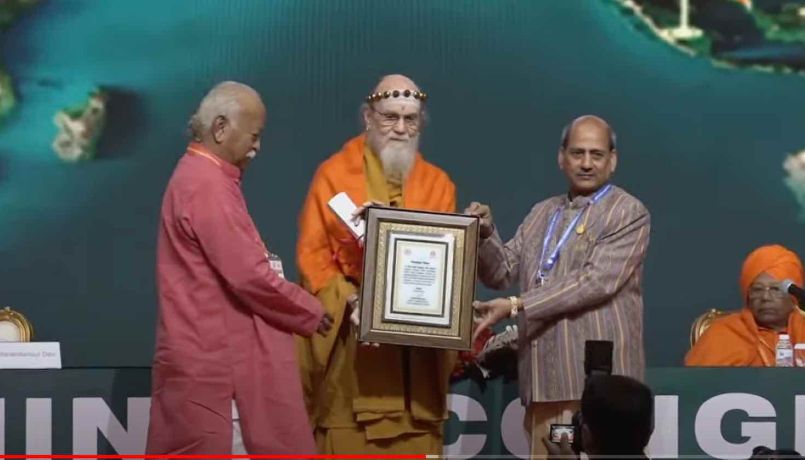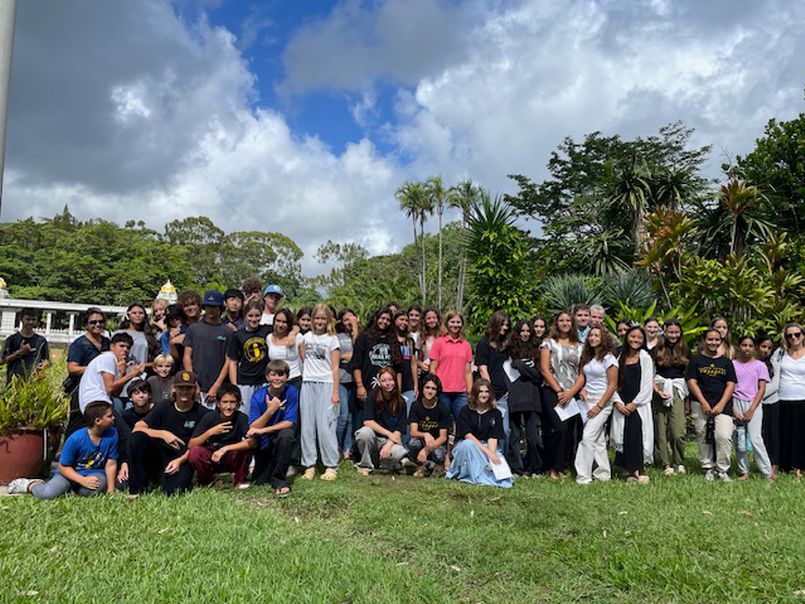Brahmachari Shankara Performs Saiva Atmartha Puja
One of the requirements for our monastic aspirants is to learn the Saiva Atmartha Puja and then, soon before taking his first monastic vows, perform it in front of all the monks. This puja is learned by all of our Saiva Siddhanta Church formal sishyas.
After taking monastic vows, Brahmachari Shankara will learn the parartha puja, "worship for the benefit of others", that is performed in temples.
Russian Language Initiatives

The team in Moscow continues to repurpose our Himalayan Academy work energetically. Their team leader, Dinanatha Bodhiswami, emailed a few days back sharing that they wish to add the Saivite Hindu Religion, Book One to their list of books. Having done the entire trilogy and Loving Ganesha, they seek to reach the young ones.
It is a simple book, all in black and white, giving dharmic teachings in four languages: English, Tamil, Bahasa Malaysia and French. Each page is illustrated with the concept being presented to the children. The files were sent and now translation will take place ahead of printing.
CyberCadets will know that this same team has been publishing Hinduism Today in Russian for several years, and each year compiles the four issues into a bound volume, shown in the slideshow.
.
Serving the Dharmic Religions #4 – Hinduism
Over the last year, our publications team in Kauai has been quietly working on a sizable side project sponsored by the Uberoi Foundation. The project is intended to assist in the presentation of the four Dharmic faiths, Hinduism, Buddhism, Jainism and Sikhism, as per the foundation's goal. This particular video is meant to teach about the Hindu religion in California 6th grade social studies classes. The Malibu Hindu Temple's main shrine is dedicated to Lord Vishnu. It was built in the traditional style of South India and opened in 1981. Students were welcomed into the temple and given an overview of the beautiful architectural features. They then participated in an archana (special prayer) in front of the main shrine. The tour continued with visits to the smaller surrounding shrines while learning of the attributes of the Deities and concluded with insightful questions asked by the group.
Directed by Mainak Dhar, Produced by Gabriel Bruskoff.
Serving the Dharmic Religions #3 – Sikhism
Over the last year, our publications team in Kauai has been quietly working on a sizable side project sponsored by the Uberoi Foundation. The project is intended to assist in the presentation of the four Dharmic faiths, Hinduism, Buddhism, Jainism and Sikhism, as per the foundation's goal. This particular video is meant to teach about the Sikh religion in California 6th grade social studies classes. The Hollywood Sikh Temple was founded in 1969 by Dr. Amarjit Marwah on the 500th Birth Anniversary of Guru Nanak. The present building was completed in 1996. A small group of students visited the gurdwara (House of the Guru) and were asked to remove their shoes, wash their hands and don head coverings. A temple guide then explained the three key principles of the Sikh faith: Remember God in everything you do, share with others before you share with yourself and earn an honest living by being honest. The students were given an overview of the origins and beliefs of the Sikh faith as they toured the temple.
Directed by Mainak Dhar, Produced by Gabriel Bruskoff.
Iraivan Perimeter Wall Final Three Panels Installed
A long project full of love and thoughtful effort has come to a close. A team from Pacific Concrete, Cutting & Coring came up some days ago to install the final three metal panels on the perimeter wall of Iraivan Temple. They are:
#7-- The Panchabrahma Mantra
#27-- A Saiva Siddhanta Creed in Sanskrit
#30-- Verses From the Vedas
The panels gleam in the afternoon sun today. Another stage of the temple structure is complete. Aum Namasivaya.
Today’s Micro Game

As with spiritual perceptions, all things look quite different at different scales. Imagine your awareness expanding to infinite vastness. Now, bring yourself closer to earth, above the planet 100 miles high. Look at your city, home and family, viewing them from that immensity. Frame of reference changes our perceptions, as all astronauts can attest.
We took our iPhone into the garden today and captured some close-ups and we now challenge you to identify what they are at normal scale. Good luck. If you get all four, the game devas will sing you a song.
Ganapati Kulam Brainstorming Meeting
Every once in a while the Ganapati Kulam spends the morning at our seaside condo to casually discuss the overview of things and brainstorm new ventures.
Today we looked at the progress of a new version of our main websites that is nearing completion, examined ways to bring Gurudeva's audio voice forward more, and noted potential collaborations with well wisher volunteers along with organizations that we recently met at the World Hindu Congress in Bangkok
Bangkok Congress

The World Hindu Congress, held every four years, invited Satguru Bodhinatha Veylanswami to Bangkok to receive a special honorary award. He and Arumuganathaswami flew there and attended three days of events and panels. On the first night, the award was given from the stage before a crowd of some 2,000 Hindu leaders from across the globe.
Arumuganathaswami presented a Keynote on the magazine during one of six Hindu Media conferences. He also played the one minute Iraivan trailer to introduce all to Kauai Aadheenam, and we are told there were near gasps from the audience in seeing the beauty and sanctity of Mahalingesvara's Hawaiian home.
You can see a short and articulate introduction by clicking on the video below, followed by Bodhinatha's ten-minute presentation:
Island School Visit, and San Marga Ganesha Shrine

Two events in one post:
1) A couple weeks ago Island School made their annual student field trip over here as part of studying world religions. They also visited other religions' places of worship on the island.
Isani Alahan gave a tour which included attending part of the Siva puja in Iraivan Temple. Most of these photos were taken by 8th grade teacher Pat Gegen. He reported afterwards, "Thank You again for the wonderful tours you provide for us and our students and the wisdom and insights into better understanding Hinduism as practiced here on Kauai. I continue to learn more every year and it is always a highlight for the students."
2) The other day we affixed a kalasam to the top of the small Ganesha shrine on San Marga path. A Ganesha murti will be officially installed inside in the coming weeks.
Saiva Siddhanta Church Sishya Family on Pilgrimage
A couple days ago, Vandana received Vishesha Diksha, the second of two dikshas that Saiva Siddhanta Church sishyas prepare for. Below is the description from Gurudeva's 1995 Saiva Dharma Shastras book, slightly updated for the current context.
Vishesha diksha,"distinguishing" initiation, marks the sishya's formal entrance into the Sri Subramuniya Rishi Gotra, our lineage's select assembly of followers, affectionately known as chelas. After this initiation, the devotee is obligated to personally, daily perform the Saiva Atmartha Puja, which now has new power. This worship is performed during the early morning, followed by scriptural study and 108 repetitions of the Panchakshara Mantra. The puja obligation of vishesha diksha is not fulfilled by attending the puja performed by the head of the house in the shrine room. Each member who has received this initiation performs the puja privately (the long, medium or short version) and then attends the family puja as well. Vishesha diksha is also the empowering to perform yoga, to worship internally and undertake serious austerities. This diksha opens access into inner realms heretofore not accessible. As part of the diksha, the sishya voices and signs the following solemn vow binding herself and her family line to the Sri Subramuniya Rishi Gotra. Vishesha diksha brings the devotee more deeply into the study of Shum, my magical language of meditation, through the Shum Tyaef Lexicon.
Vishesha Diksha Vrata
"Prostrations to the holy feet of Lord Ganesha! Aum Sivaya! I pledge my loyalties to the Saiva Swami Sangam of Saiva Siddhanta Church, to the monistic Saiva Siddhanta theology of Rishi Tirumular and, most importantly, to the holy feet of my satguru in this life, Bodhinatha Veylanswami, as I enter the Sri Subramuniya Rishi Gotra. In doing so, I rededicate myself to the Santana Dharma and now bind myself to the congregation of devotees of Saiva Siddhanta Church, those who uphold the Saiva Dharma--Dancing with Siva: Hinduism's Contemporary Catechism and the Creed for Saivite Hindus--and seek to remold the Saiva karma by doing penance for the entire Saivite world as it moves from an agricultural into a technological era and on into a new age of space. As I sit before Guru Mahasannidhanam and the Saiva swamis and the gotra of devotees, I bow before the holy feet of Lord Nataraja, pledging my allegiance as a soldier of the within and a silent minister, emissary of duty to be well performed. I have enjoined my three bodies--soul, mental and physical--to propel new members into our fellowship and make them comfortable in our congregation. May Lord Ganesha bless me, may Lord Murugan bless me, may Lord Siva bless me. May Satguru bless me in this and from inner worlds as I join for all time as a Sivathondar the great congregation of Saiva Siddhanta Church and irrevocably blend my karma with its dharma. Anbe Sivamayam Satyame Parasivam." -------------------------
After the diksha, Kavish and Kapil read and signed pledges to perform the "Ten-Minute Spiritual Workout" and follow the yamas and niyamas to the best of their ability.
The eldest son, Tarun, will be staying on to serve with the monks for five or six months before embarking on university studies.
From Our Gurus' Teachings
Archives are now available through 2001. Light colored days have no posts. 1998-2001 coming later.
